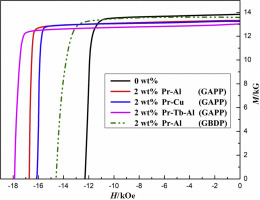当前位置:
X-MOL 学术
›
J. Rare Earths
›
论文详情
Our official English website, www.x-mol.net, welcomes your feedback! (Note: you will need to create a separate account there.)
Improvement of microstructure and coercivity for Nd-Fe-B sintered magnets by boundary introducing low melting point alloys
Journal of Rare Earths ( IF 4.9 ) Pub Date : 2020-04-01 , DOI: 10.1016/j.jre.2019.04.021 Shuai Cao , Xiaoqian Bao , Jiheng Li , Haijun Yu , Kunyuan Zhu , Xuexu Gao
Journal of Rare Earths ( IF 4.9 ) Pub Date : 2020-04-01 , DOI: 10.1016/j.jre.2019.04.021 Shuai Cao , Xiaoqian Bao , Jiheng Li , Haijun Yu , Kunyuan Zhu , Xuexu Gao

|
Abstract Different from the grain boundary diffusion process (GBDP), which is suitable for modifying thin magnet, a green-pressing agents permeation process (GAPP) that uses low melting point alloys was applied to the Nd-Fe-B green compact with a thickness over 15 mm to reconstruct the boundary microstructure of a sintered Nd-Fe-B magnet. The coercivity increases from 12.3 kOe for the sample free of Pr80Al20 to 16.8 kOe for the sample with 2 wt% Pr80Al20. By further increasing the Pr80Al20 content to 3 wt%, the coercivity increases slightly, but the remanence and Hk/Hcj deteriorate obviously. The optimal comprehensive properties of Hcj = 16.8 kOe, Br = 13.4 kG and Hk/Hcj = 0.975 are obtained at 2 wt% Pr80Al20, since matrix phase grains are separated by relatively continuous thin grain boundary layers, which weaken the magnetic coupling between adjacent grains. The coercivities of the samples from the GAPP that use 2 wt% Pr80Al20, Pr70Cu30 and Pr60Tb20Al20 alloys, respectively, can be enhanced to a large extent. However, the coercivity of the magnet reconstructed with Pr80Al20 is lower than that of the sample with Pr60Tb20Al20 but is higher than that of the sample reconstructed with Pr70Cu30 alloy. Moreover, the coercivity of the sample from the GAPP using 2 wt% Pr80Al20 is much higher than that of the sample from the GBDP, which is due to a nearly uniform boundary microstructure from the surface to the interior of the thick magnet from the GAPP, thus providing new insights into the fabrication of thick and bulky permanent magnets with high coercivity.
中文翻译:

通过边界引入低熔点合金改善 Nd-Fe-B 烧结磁体的微观结构和矫顽力
摘要 与适用于薄磁体改性的晶界扩散工艺 (GBDP) 不同,采用低熔点合金的生坯压制剂渗透工艺 (GAPP) 应用于具有一定厚度的 Nd-Fe-B 生坯。超过 15 mm 以重建烧结 Nd-Fe-B 磁体的边界微观结构。矫顽力从不含 Pr80Al20 的样品的 12.3 kOe 增加到含有 2 wt% Pr80Al20 的样品的 16.8 kOe。Pr80Al20 含量进一步增加到 3 wt%,矫顽力略有增加,但剩磁和 Hk/Hcj 明显恶化。Hcj = 16.8 kOe、Br = 13.4 kG 和 Hk/Hcj = 0.975 的最佳综合性能是在 2 wt% Pr80Al20 下获得的,因为基体相晶粒被相对连续的薄晶界层隔开,这削弱了相邻晶粒之间的磁耦合。分别使用 2 wt% Pr80Al20、Pr70Cu30 和 Pr60Tb20Al20 合金的 GAPP 样品的矫顽力可以在很大程度上提高。然而,使用Pr80Al20 重构的磁体的矫顽力低于使用Pr60Tb20Al20 的样品的矫顽力,但高于使用Pr70Cu30 合金重构的样品的矫顽力。此外,使用 2 wt% Pr80Al20 的 GAPP 样品的矫顽力远高于 GBDP 样品的矫顽力,这是由于 GAPP 厚磁体从表面到内部几乎均匀的边界微观结构,从而为制造具有高矫顽力的厚而笨重的永磁体提供了新的见解。Pr70Cu30 和 Pr60Tb20Al20 合金分别可以得到很大程度的增强。然而,使用Pr80Al20 重构的磁体的矫顽力低于使用Pr60Tb20Al20 的样品的矫顽力,但高于使用Pr70Cu30 合金重构的样品的矫顽力。此外,使用 2 wt% Pr80Al20 的 GAPP 样品的矫顽力远高于 GBDP 样品的矫顽力,这是由于 GAPP 厚磁体从表面到内部几乎均匀的边界微观结构,从而为制造具有高矫顽力的厚而笨重的永磁体提供了新的见解。Pr70Cu30 和 Pr60Tb20Al20 合金分别可以得到很大程度的增强。然而,使用Pr80Al20 重构的磁体的矫顽力低于使用Pr60Tb20Al20 的样品的矫顽力,但高于使用Pr70Cu30 合金重构的样品的矫顽力。此外,使用 2 wt% Pr80Al20 的 GAPP 样品的矫顽力远高于 GBDP 样品的矫顽力,这是由于 GAPP 厚磁体从表面到内部几乎均匀的边界微观结构,从而为制造具有高矫顽力的厚而笨重的永磁体提供了新的见解。Pr80Al20重构磁铁的矫顽力低于Pr60Tb20Al20试样,但高于Pr70Cu30合金重构试样。此外,使用 2 wt% Pr80Al20 的 GAPP 样品的矫顽力远高于 GBDP 样品的矫顽力,这是由于 GAPP 厚磁体从表面到内部几乎均匀的边界微观结构,从而为制造具有高矫顽力的厚而笨重的永磁体提供了新的见解。Pr80Al20重构磁铁的矫顽力低于Pr60Tb20Al20试样,但高于Pr70Cu30合金重构试样。此外,使用 2 wt% Pr80Al20 的 GAPP 样品的矫顽力远高于 GBDP 样品的矫顽力,这是由于 GAPP 厚磁体从表面到内部几乎均匀的边界微观结构,从而为制造具有高矫顽力的厚而笨重的永磁体提供了新的见解。
更新日期:2020-04-01
中文翻译:

通过边界引入低熔点合金改善 Nd-Fe-B 烧结磁体的微观结构和矫顽力
摘要 与适用于薄磁体改性的晶界扩散工艺 (GBDP) 不同,采用低熔点合金的生坯压制剂渗透工艺 (GAPP) 应用于具有一定厚度的 Nd-Fe-B 生坯。超过 15 mm 以重建烧结 Nd-Fe-B 磁体的边界微观结构。矫顽力从不含 Pr80Al20 的样品的 12.3 kOe 增加到含有 2 wt% Pr80Al20 的样品的 16.8 kOe。Pr80Al20 含量进一步增加到 3 wt%,矫顽力略有增加,但剩磁和 Hk/Hcj 明显恶化。Hcj = 16.8 kOe、Br = 13.4 kG 和 Hk/Hcj = 0.975 的最佳综合性能是在 2 wt% Pr80Al20 下获得的,因为基体相晶粒被相对连续的薄晶界层隔开,这削弱了相邻晶粒之间的磁耦合。分别使用 2 wt% Pr80Al20、Pr70Cu30 和 Pr60Tb20Al20 合金的 GAPP 样品的矫顽力可以在很大程度上提高。然而,使用Pr80Al20 重构的磁体的矫顽力低于使用Pr60Tb20Al20 的样品的矫顽力,但高于使用Pr70Cu30 合金重构的样品的矫顽力。此外,使用 2 wt% Pr80Al20 的 GAPP 样品的矫顽力远高于 GBDP 样品的矫顽力,这是由于 GAPP 厚磁体从表面到内部几乎均匀的边界微观结构,从而为制造具有高矫顽力的厚而笨重的永磁体提供了新的见解。Pr70Cu30 和 Pr60Tb20Al20 合金分别可以得到很大程度的增强。然而,使用Pr80Al20 重构的磁体的矫顽力低于使用Pr60Tb20Al20 的样品的矫顽力,但高于使用Pr70Cu30 合金重构的样品的矫顽力。此外,使用 2 wt% Pr80Al20 的 GAPP 样品的矫顽力远高于 GBDP 样品的矫顽力,这是由于 GAPP 厚磁体从表面到内部几乎均匀的边界微观结构,从而为制造具有高矫顽力的厚而笨重的永磁体提供了新的见解。Pr70Cu30 和 Pr60Tb20Al20 合金分别可以得到很大程度的增强。然而,使用Pr80Al20 重构的磁体的矫顽力低于使用Pr60Tb20Al20 的样品的矫顽力,但高于使用Pr70Cu30 合金重构的样品的矫顽力。此外,使用 2 wt% Pr80Al20 的 GAPP 样品的矫顽力远高于 GBDP 样品的矫顽力,这是由于 GAPP 厚磁体从表面到内部几乎均匀的边界微观结构,从而为制造具有高矫顽力的厚而笨重的永磁体提供了新的见解。Pr80Al20重构磁铁的矫顽力低于Pr60Tb20Al20试样,但高于Pr70Cu30合金重构试样。此外,使用 2 wt% Pr80Al20 的 GAPP 样品的矫顽力远高于 GBDP 样品的矫顽力,这是由于 GAPP 厚磁体从表面到内部几乎均匀的边界微观结构,从而为制造具有高矫顽力的厚而笨重的永磁体提供了新的见解。Pr80Al20重构磁铁的矫顽力低于Pr60Tb20Al20试样,但高于Pr70Cu30合金重构试样。此外,使用 2 wt% Pr80Al20 的 GAPP 样品的矫顽力远高于 GBDP 样品的矫顽力,这是由于 GAPP 厚磁体从表面到内部几乎均匀的边界微观结构,从而为制造具有高矫顽力的厚而笨重的永磁体提供了新的见解。


























 京公网安备 11010802027423号
京公网安备 11010802027423号